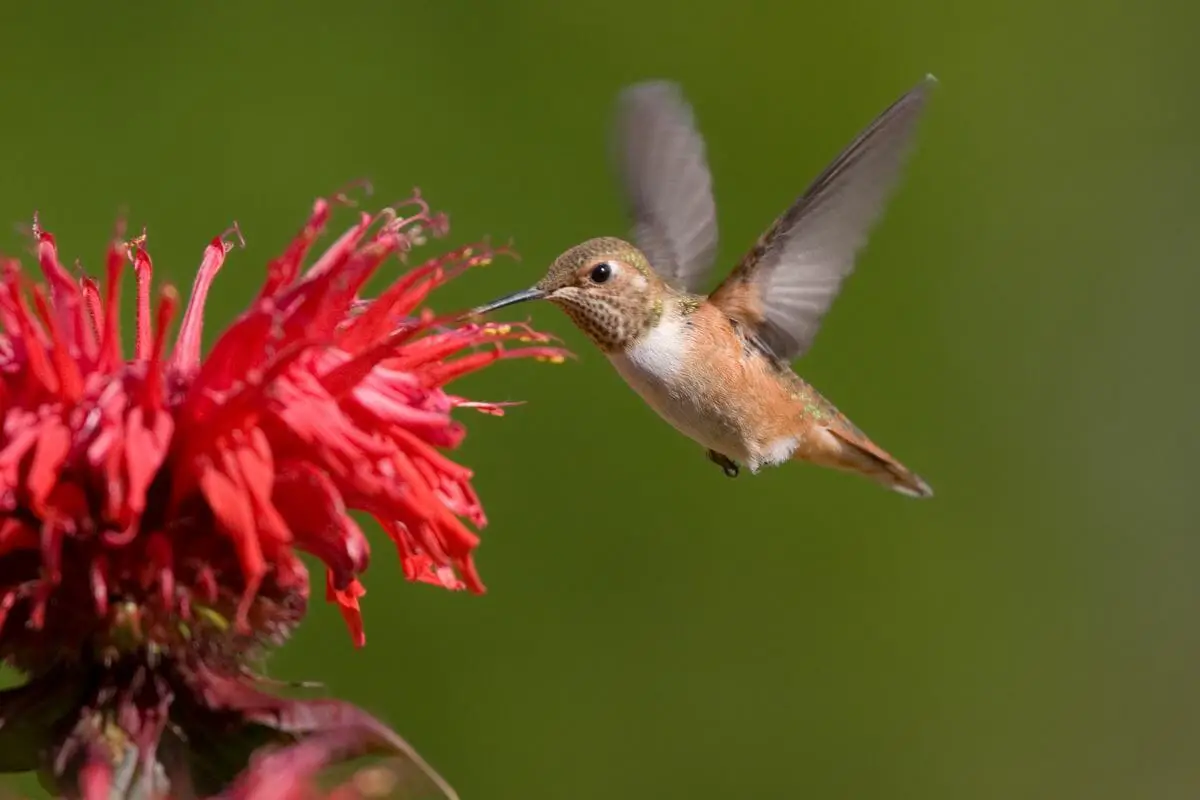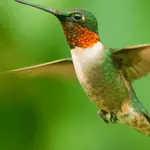There are more than 300 species of hummingbirds around the globe, but less than a dozen of them travel as far north as the United States and Canada, and even fewer of them remain there during the whole winter.
But despite this, hummingbirds are popular birds that can be found being cared for in the backyards of tens of thousands of homes.

These homes have hummingbird feeders, flowers that are high in nectar, and bird watchers who are passionate about their hobby.
Here are the most common types of hummingbirds that you may spot on your next bird-watching outing.
Ruby-Throated Hummingbird
In eastern North America, the only species of hummingbird that is reliably seen is the ruby-throated hummingbird.
Other species of hummingbirds may turn up at any time, but the ruby-throated hummingbird is the only one seen regularly.
The males have a gorget that is an eye-catching strawberry red color and are distinguished by a white-collar that sits on the throat. It is this characteristic that has earned this hummingbird its name
Both sexes of this species have iridescent green upperparts and white underparts, although the males of this species are more flamboyant than the females.
It is not uncommon to spot one of these hummingbirds in a suburban or urban park or garden, particularly in locations where flowers with a high nectar content are cultivated.
Backyards are another typical location for this species. They also commonly visit feeders that have been constructed with the express purpose of drawing them in.
This species is sometimes referred to by its scientific designation, Archilochus colubris.
It is during the summer months that breeding takes place in the eastern and central areas of the United States, as well as along the southern border of the eastern and central parts of Canada.
Broad-Tailed Hummingbird
This species, which was given its common name from the scientific genus Selasphorus platycercus, spends the summer months breeding in the mountainous regions of the southwestern United States.
Populations of this species have been found as far west as eastern California and as far north as southern Idaho.
The broad-tailed hummingbird and the above eastern ruby-throated hummingbird may appear to belong to the same species.
However, the two species may be distinguished from one another by looking at where they are found in their respective ranges.
Another way to tell them apart is to look at their tails. Broad-tailed hummingbirds have a rufous patch around the base of their tails, but ruby-throated hummingbirds do not have this feature.
In addition, in contrast to female ruby-throated hummingbirds, female broad-tailed hummingbirds have a rufous wash on their flanks and streaking on their necks.
Ruby-throated hummingbirds do not have these characteristics.
One of the most obvious qualities that may be used to identify a broad-tailed hummingbird is the distinctive “zinging” sound created by its wings while it is in flight.
When in flight, the wings of many species of hummingbirds produce a soft thumping sound; however, the wings of male broad-tailed hummingbirds produce a sound that is far louder and more distinct.
Even though they spend much of their time in meadows and other open areas at the lower elevations of the mountains, broad-tailed hummingbirds regularly stop by nectar feeders when they are traveling.
This pattern of activity occurs most frequently in the early spring and late fall.
Rufous Hummingbird

The species in question is referred to by its scientific name, Selasphorus rufus.
Breeding normally takes place in the summer along the northern Pacific coast of North America, which includes the states of Washington, Oregon, Idaho, and British Columbia, though there are accounts of these birds mating as far north as Alaska.
A variety of bird species choose to spend the colder months of the year in the southeastern United States and along the Gulf Coast of the country.
Because of their orange plumage and sparkling orange-red throats, male rufous hummingbirds are very simple to recognize.
Females are not readily recognized from males, although they do have a rufous wash over their green upper parts and along their flanks, which borders their white breast and belly.
In addition to this, some markings appear on the females’ necks.
These are very territorial birds, and rufous hummingbirds will regularly fight and drive away any intruders who approach near their nests or the preferred feeding locations for their young if they feel threatened in any way.
They usually visit feeders that are stocked with nectar, but those who monitor birds should remember the need of maintaining a safe distance between each feeder to prevent aggressive behavior.
Allen’s Hummingbird
This species, which was given the common name Selasphorus sasin after the scientific genus to which it belongs, spends the summer months mating along the coast of California, all the way from the southern border of Oregon to Los Angeles.
Because the plumage of both species is orange, rufous hummingbirds and Allen’s hummingbirds are sometimes confused with one another.
On the other hand, a more in-depth look reveals that Allen’s hummingbirds have a back and head that are substantially more green and that the orange on their sides is significantly more prominent.
Both the males and females of this species look almost identical though.
These birds have a somewhat broad range for their size, and their habitats range from open forests to residential gardens.
They will regularly visit nectar feeders, particularly in the early part of spring when they are just beginning to make their way back after migrating south for the winter.
Costa’s Hummingbird
This species of Calypte is referred to by its scientific name, Calypte costae.
In terms of its geographical reach, you can find this bird in the southeastern part of California, the southwestern corner of Arizona, and even the southernmost tip of Nevada.
During the summer, the range of this species’ breeding range shifts more to the north and east.
The male Costa’s hummingbird is easily identified by its distinctive gorget and vivid purple or pinkish crown, both of which taper down into pointed projections at the sides of the neck.
This is where the name of the species comes from.
Females do not have the iridescent coloring that is found on males, but they do have green upperparts, white underparts, and a little wash of green along the sides of their bodies instead.
These little birds thrive best in arid, open parts of the planet since the desert provides the optimum habitat for them.
Even though they are seldom spotted in metropolitan areas, they can find their way into the backyards of suburban homes that are located on the city’s outskirts.
Summary
These are just 5 of the dozens of hummingbird species that can be found in North America. Keep an eye out next time you go bird watching and you may find even more!








